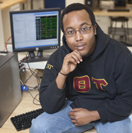 Interdisciplinary research conducted by Binghamton University students provides new insights about biofilms — slimy coatings of bacteria — as well as new ways to study them.
Interdisciplinary research conducted by Binghamton University students provides new insights about biofilms — slimy coatings of bacteria — as well as new ways to study them.
Last summer, senior Mario Alexandre, a computer engineering major, was paired with a biology major through a $1.4 million, four-year grant from the Howard Hughes Medical Institute, or HHMI. The grant supports projects that solve problems in the life sciences; undergraduates work with faculty mentors on original research.
The biologists in Alexandre’s group worked with flow cell systems for multiple bacteria species to model their behavior. A few hundred images were taken in a 3D space, and were then sliced into 2D images. Alexandre developed software to analyze these images for different properties and determine specific characteristics, such as density, of the bacteria in question.
The research, which could translate into increased effectiveness for medications and vaccinations, revealed that more bacteria were on the outside than inside of the biofilms. “This means medicine can only penetrate halfway through and can only kill the first layer of cells,” Alexandre said. “You’ll only weaken the actual infection; you won’t beat it.”
He continues to work with the analysis generated during the summer with plans to pass the research back to the biologists. Alexandre is developing a user interface that will allow biologists to run tests with speedy results and view directories of all the images.
“The experience introduces Mario to an area of study that is not usually in the engineering curriculum,” said Anna Tan-Wilson, a distinguished teaching professor and the HHMI program director. “He is doing research in the life sciences. This kind of interdisciplinary work is seeing a lot of growth within engineering research, and it expands Mario’s career opportunities.”
Alexandre said the project helped him to think differently about his own field. “Knowing that image processing, a component of both computer science and electrical engineering, can greatly aid the development of biology was amazing,” he said. “I didn’t know you could do that.”







